Fri, 20 September 2024 03:03:32am
Related Tags: 2024 election stock market, S&P 500 election year performance, Kamala Harris 2024 campaign, Donald Trump election impact, Investing strategy election year
Presidential Election 2024: Will the election year really spell doom or boom for the S&P 500

Presidential Election 2024: Will the election year really spell doom or boom for the S&P 500
As the 2024 presidential election looms, investors are on edge, wondering how the political turmoil might affect the stock market. With the recent exit of President Joe Biden and the fierce competition between former President Donald Trump and Vice President Kamala Harris, the stakes are high. But does the election year really spell doom or boom for the S&P 500? Historical data may hold the key to predicting market behavior in these unpredictable times.
As the 2024 presidential election approaches, investors are bracing for what could be one of the biggest market-moving events of the year. The unexpected exit of President Joe Biden has added another layer of uncertainty, with former President Donald Trump currently leading Vice President Kamala Harris in most national polls. Despite this lead, the Harris campaign is just beginning to gain momentum, and much could change before the November election.
S&P 500 Performance in Election Years:
Historically, the S&P 500 has averaged a 7% gain during U.S. presidential election years since 1952. While this figure is positive, it pales in comparison to the 17% average gain in the year preceding an election year. Additionally, the typical annual return for the S&P 500 is around 10%, indicating that election years can be somewhat lackluster for investors.
The current economic landscape is further complicated by the Federal Reserve’s high-interest rates, which are at their highest level in over two decades as the Fed combats inflation. Elevated interest rates increase borrowing costs for both consumers and corporations, potentially slowing economic growth. Despite a 2.8% GDP growth in the second quarter, economists predict a slowdown, with a 55.8% chance of a recession within the next 12 months according to the New York Fed’s model.
Sector Performance During Election Years:
Since 1973, financial services and energy sectors have performed well during presidential election years, while the technology sector, a top performer in non-election years, has struggled. Investors looking to capitalize on historical trends might consider increasing their allocation to financial services and energy sector ETFs, such as the Financial Select Sector SPDR Fund (XLF) and the Energy Select Sector SPDR Fund (XLE).
2024 Election Cycle Chaos:
The 2024 election cycle has already been marked by unprecedented events. On July 13, Trump survived an assassination attempt in Butler, Pennsylvania. Shortly thereafter, Biden announced he would not seek re-election, paving the way for Harris as the presumptive Democratic nominee. Such political turmoil is reminiscent of 1968, when President Lyndon Johnson chose not to run for re-election and Democratic nominee Robert F. Kennedy was assassinated.
Despite the chaos of 1968, the S&P 500 rallied 15% following Johnson’s announcement and ended the year with a 7.7% gain. This historical resilience suggests that the market can withstand significant political disruptions.
Economic Performance Under Biden vs. Trump:
Comparing the economic performance under Trump and Biden offers some insight for investors. During Trump’s presidency, the S&P 500 gained about 14.1% annually, while under Biden and Harris, it has gained approximately 10.8% annually. One of the key differences is inflation: cumulative inflation was 5.4% during Trump’s first 41 months, compared to 19.9% under Biden’s administration.
However, the COVID-19 pandemic severely disrupted the economy under both administrations, making direct comparisons challenging. While the U.S. economy averaged just 1.4% annual GDP growth under Trump, it saw a 3.5% growth rate during Biden’s first three years, excluding pandemic-related impacts.
2024 Investing Strategy:
Analysts remain cautiously optimistic about the stock market’s outlook for 2024. The consensus price target for the S&P 500 suggests a 13.6% upside over the next 12 months. Analysts see the most potential in the communication services sector (22.1%) and the least in the real estate sector (8.4%).
Small-cap stocks have also been outperforming recently, and this trend is expected to continue. With potential rate cuts by the Federal Reserve, smaller companies could benefit disproportionately.
Conclusion:
As the 2024 election year unfolds, investors should prepare for volatility but remain optimistic about long-term prospects. Historical data suggests that despite political turmoil, the stock market can perform robustly. By strategically allocating investments and focusing on sectors with historical strength, investors can navigate the election year with confidence.
Key Points:
- The S&P 500 has historically gained 7% during presidential election years.
- Financial services and energy sectors perform well during election years.
- The 2024 election cycle has already seen unprecedented events, including Biden’s exit and an assassination attempt on Trump.
- Economic performance under Biden and Trump shows differing impacts on the S&P 500.
- Analysts predict a 13.6% upside for the S&P 500 over the next 12 months.




